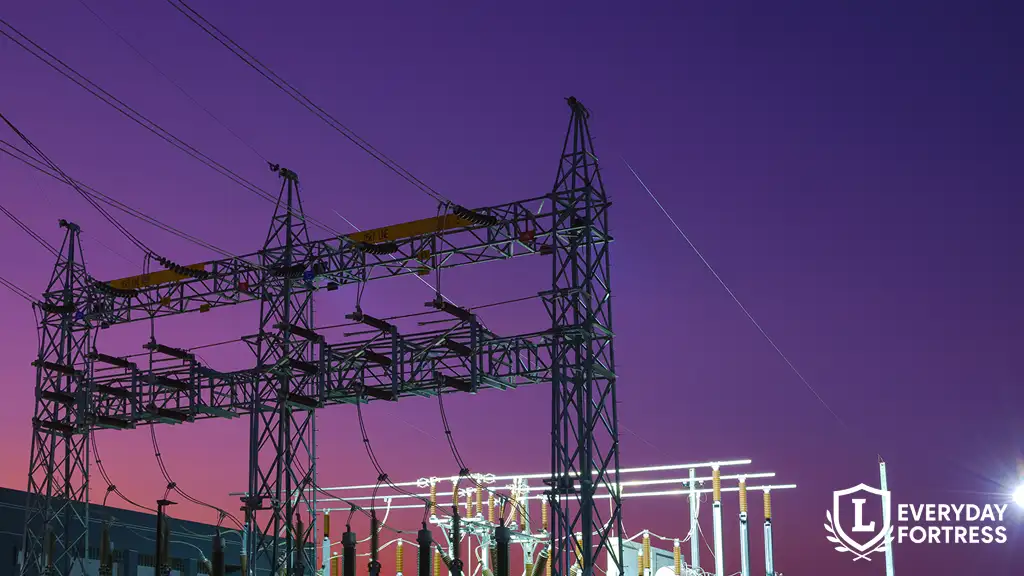Cities rely on electricity for nearly everything — lights, water, transit, and communication. But what if the grid goes down for days or longer? It’s more common than many realize, and it’s critical to prepare for a power grid failure in the city before it happens. This guide walks you through simple, effective ways to stay safe during an urban blackout.
Why Urban Blackouts Are So Dangerous
Unlike rural areas where generators and well water may be options, cities rely on tightly connected infrastructure. When the grid goes down:
- Elevators stop
- Water pumps fail (leading to no tap water above the ground floor)
- Traffic signals go dark
- ATMs and card readers stop working
- Grocery store refrigeration shuts off
- Public transit may stop completely
Without preparation, even a 24-hour blackout in a city can become chaotic — and a multi-day outage can turn dangerous.
What Causes Grid Failures in Cities?
Several scenarios can trigger widespread urban outages:
1. Extreme Weather
Heatwaves, winter storms, hurricanes, and floods can overwhelm local utilities or damage key transformers.
2. Cyberattacks
Hackers have already targeted energy infrastructure in the U.S. and abroad. Power grids are prime targets due to their complexity and importance.
3. Overloaded Systems
Old power lines and outdated transformers often fail during peak demand, especially during hot summers.
4. Grid Imbalance or Cascading Failures
When one part of the grid goes down, it can trigger a domino effect, blacking out entire regions.
How to Prepare for a Power Grid Failure in the City
Here’s what you can do now to make sure you’re ready to handle a blackout calmly and safely — even in a high-rise apartment or dense urban neighborhood.
1. Store Emergency Water
Most city water systems rely on electric pumps. If power goes out, water pressure may drop fast — especially in buildings above the second floor.
Prep tip:
- Store at least one gallon per person per day (3-day minimum)
- Use refillable jugs, stackable containers, or water bricks
- Freeze some bottles to help keep your fridge cool longer
2. Keep a Non-Electric Food Supply
Grocery stores rely on refrigeration and daily restocking. In a blackout, food goes fast.
Store foods that require no refrigeration or cooking:
- Canned tuna, chili, and beans
- Nut butters and trail mix
- Crackers, shelf-stable milk, protein bars
- Manual can opener (non-electric)
3. Set Up Alternative Lighting
Dark apartments and stairwells are safety hazards.
Options include:
- LED lanterns
- Headlamps
- Battery-powered or solar flashlights
- Extra batteries (and test them monthly)
Avoid candles — they’re a fire risk in small spaces or multi-unit buildings.
4. Secure a Backup Power Source (if Possible)
Generators are often prohibited in apartments. Instead, consider:
- High-capacity power banks (20,000 mAh+)
- Solar-powered chargers for phones or USB gear
- A portable power station (like a Jackery or EcoFlow)
Use these to charge essentials like phones, radios, or small fans.
5. Download Offline Maps and Critical Apps
You may lose internet access if towers go down or routers lose power.
Install or download:
- Google Maps offline
- Red Cross Emergency app
- Notes app with emergency contacts
- Transit or rideshare apps with local service alerts
Keep everything updated and ready without relying on Wi-Fi.
6. Prepare for No Heat or Cooling
Apartments heat up or cool down fast without electricity.
Hot weather:
- Battery-operated fan
- Blackout curtains to block sun
- Water spray bottle for cooling
- Electrolyte tablets or powder
Cold weather:
- Thermal blankets
- Wool socks, gloves, and base layers
- Tent or tarp to create a warm enclosed space in one room
- Battery-powered hand warmers
7. Secure Your Fridge and Freezer Strategy
Food safety is critical. Know how long items will last:
- A full freezer can keep food cold for up to 48 hours
- A fridge will stay safe for about 4 hours unopened
Prep tips:
- Keep a freezer thermometer inside
- Freeze jugs of water now to act as backup cooling
- Eat perishables first — keep a list taped to the door
8. Have Cash on Hand
ATMs and card readers will likely go down.
- Keep $100–$200 in small bills
- Store it in a waterproof envelope in your go-bag or safe
- Use it for food, water, or supplies if electronic payments fail
9. Stay Informed With a Battery-Powered Radio
When the internet’s down, radio is your emergency news source.
Look for:
- AM/FM with NOAA weather alerts
- Hand crank or solar charging
- USB port to charge small devices
This keeps you aware of restoration timelines, evacuation zones, and public updates.
10. Build a Local Contact Plan
City networks fail quickly in emergencies. Cell towers get overwhelmed. Wi-Fi disappears.
Create a plan:
- Share your location with one out-of-town contact
- Choose a local meeting point
- Write down phone numbers (don’t rely only on your phone)
- Use walkie-talkies if in the same building or complex
🧠 You May Wanna Check Out:
- Top 10 Items You Need in Every Emergency Preparedness Kit
- Urban Emergency Kit Checklist for Apartment Dwellers
Final Thoughts
A city-wide power grid failure is no longer just a prepper scenario — it’s a real possibility, especially as infrastructure ages and extreme weather becomes more frequent.
Preparing now means avoiding panic later. Focus on water, food, lighting, communication, and temperature control. You don’t need a bunker — just a smart plan and the right supplies.
For more grid-down readiness tips, check out Ready.gov’s power outage checklist.


